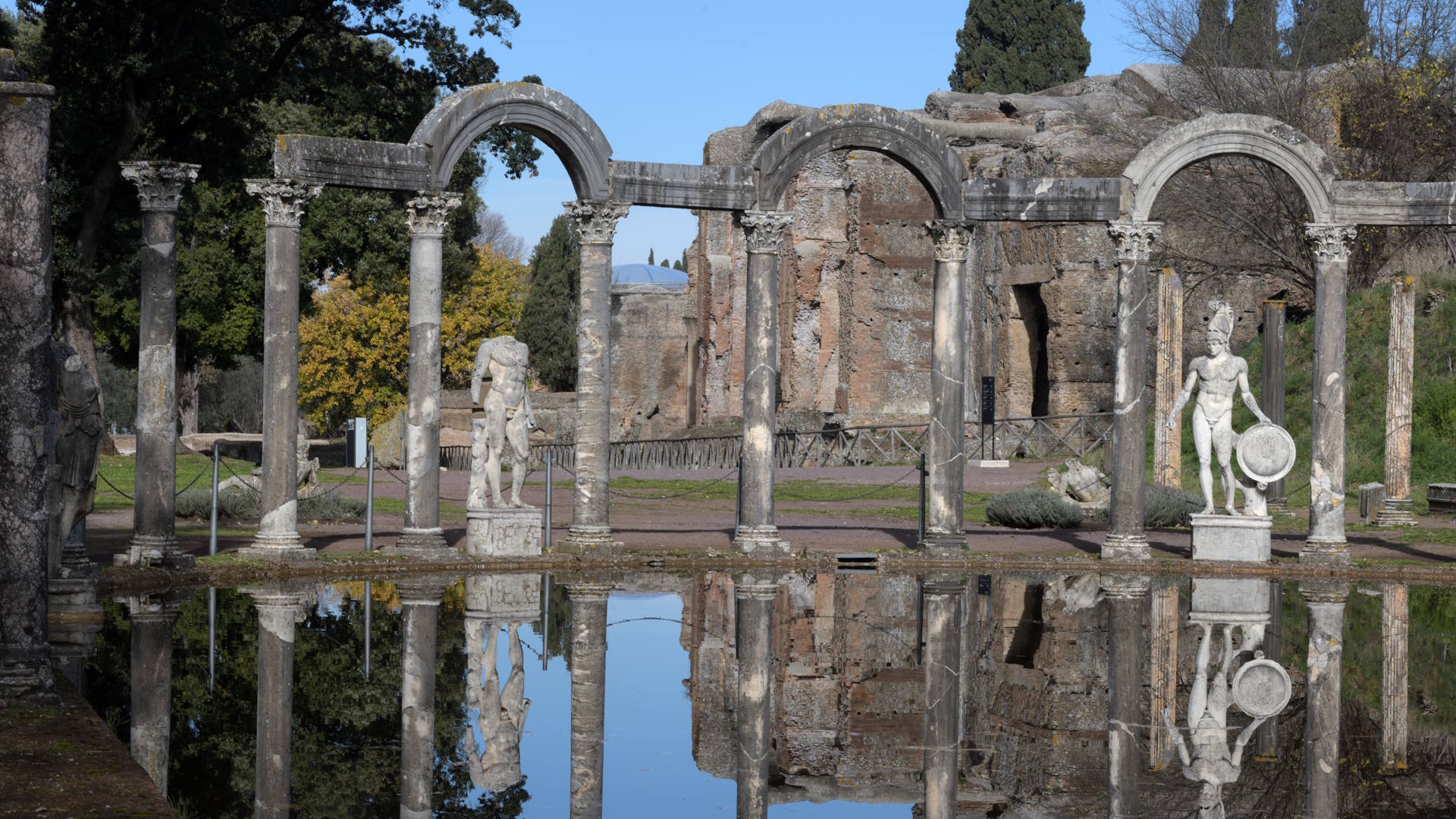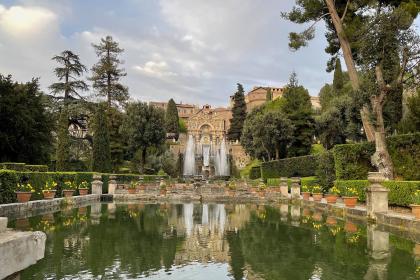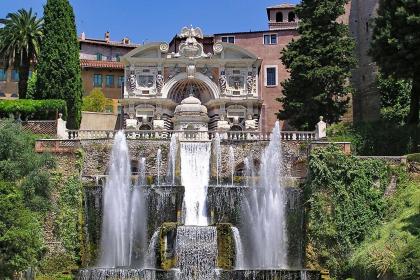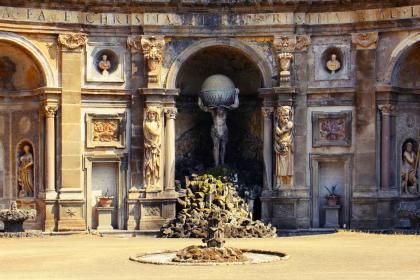
Built by the Emperor Hadrian (117-138 AD), in a large valley rich in of green and water near Tivoli - the ancient Tibur - the Villa extended over an area of at least one hundred and twenty hectares, including residential structures, baths, nymphaeums, pavilions and gardens. Due to its size and exceptional state of conservation, it can certainly be considered the most famous of the villas located in the surroundings of Rome. Its structures constitute in fact one of the most important and admirable examples of Roman architecture; all the various buildings were also connected to each other, in addition to surface paths, also by an underground network of roads for vehicles and pedestrians, functional to services.
The villa was probably begun after the return of the emperor Hadrian from his long journey in the eastern provinces, in 126 AD. It was after this journey, in fact, that Hadrian decided to reproduce in his villa the places and buildings that had fascinated him the most, such as the Lyceum, the Academy and the Pecile in Athens, the Canopus, a canal on the Nile delta, and the Tempe Valley in Thessaly. Although it is based on the traditional layouts of Roman villas, Hadrian's Villa reflects the architectural genius of its owner, in which inventiveness plays an important role, also thanks to innovative architectural solutions. Upon Hadrian's death, the villa passed to his successors, who restored and embellished it. Already partly stripped of its works of art by Constantine (306-337 AD) who took them to Constantinople, it was devastated during the barbarian invasions and used in the Middle Ages as a quarry for building materials by the inhabitants of Tivoli. From the Renaissance onwards, many famous artists came to study the ruins of the villa, in many cases leaving their signatures on the walls; from the nineteenth century onwards, scientific excavations and restorations began to be carried out.
At the beginning of the itinerary there is a reconstructive model of the villa; after that, the first building we come across is the Pecile, a large portico with a garden and a pool in the centre, used for long walks in the sun or shade. From the north-eastern corner of the Pecile we pass to the Hall of the Philosophers, a large room with niches, probably to be identified as a library. Next comes the Villa dell’Isola or Maritime Theatre, a circular building surrounded by a splendid portico with Ionic columns that is reflected in the water, so called because the trabeation featured a refined marble frieze with a marine subject. In the centre, isolated by a canal so as to form a sort of islet which was accessed via wooden swing bridges, there was a small villa with rooms and thermal areas, the remains of which are still visible today. The islet was certainly the most private and exclusive place in the Villa, where the emperor could isolate himself completely from the world. To the south of the Teatro Marittimo is a thermal building called “Elio Camino” composed of several rooms with tubs for cold and warm water and a large circular room occupied by a tub, with heating systems under the floor and five large windows to let in plenty of sun rays (hence the term helio caminus), which must have heated the room. The tub was probably used for steam baths or sand baths. On the east side of the Pecile is a courtyard, interpreted as a nymphaeum, and a series of buildings including a banquet hall; further on are the two thermal complexes of the Small and Big Baths where all the buildings that made up the Roman baths are still well preserved, with the gymnasium, changing rooms, tubs for hot and cold water. After passing this group of buildings, you come to a small, long and narrow artificial valley, the so-called Canopus, inspired by the Egyptian city of the same name near Alexandria. In the centre there is a pool surrounded by columns, at the bottom a temple-nymphaeum (monumental fountain) called the Serapeum, semicircular in shape, decorated with Egyptian sculptures and statues of Antinous, the young favourite of the emperor who died mysteriously in Egypt in 130 AD and was later deified. Also dedicated to the young man is the Antinoeion, a vast building recently discovered, consisting of a large circular exedra, preceded by a rectangular enclosure, which enclosed two facing temples and located along the access road to the "Great Vestibule", in front of the Hundred Chambers. It is a temple-tomb that served as a place of remembrance built to remember Antinous when he was alive and celebrate him when he was dead. Continuing along the route, you come across other remains of buildings that refer to the so-called Praetorium and Barracks of the Firemen, which should be considered rather as warehouses; after these, there is the complex of the imperial palace, where there are four main groups of important buildings: the Golden Square, the Doric Atrium, the Peristyle of the Palace and the Courtyard of the Libraries. The Golden Square consists of a large courtyard surrounded by a portico with columns and a group of rooms arranged around a large octagonal hall; it is perhaps a place for summer banquets. The Doric Atrium is a large room with a portico, perhaps two floors high; through the Peristyle of the Palace, you then arrive at the Courtyard of the Libraries, where different buildings overlook a portico with Corinthian columns; on one side there is a series of bedrooms for guests (Hospitalia), while at the back of the courtyard there are two buildings interpreted as libraries, one Latin and one Greek. From here you go up towards the Pavilion and the Terrace of Tempe; this is a belvedere consisting of a three-storey building, which dominates the valley below, created artificially to recall the famous valley of Tempe in Thessaly. A small grove follows that leads to the Casino Fede, built in the 18th century above a nymphaeum of the villa, and finally a small theatre intended for private shows for the emperor, with a capacity of 500 seats.
Before leaving the complex, it is possible to visit the museum, which houses various artefacts discovered in the Villa starting from the 1950s, during numerous excavation campaigns, including four replicas of the Caryatids of the Erechtheion in Athens, which once adorned the Canopus.
Photo: Canopus, Villa Adriana - courtesy of Le Villae - Villa Adriana e Villa d'Este-MiC
Villa d'Este

 Condividi
Condividi
Tivoli and its Villas

 Condividi
Condividi
Discover the amazing city and its magnificent villas
A journey through the suggestive villages of the Castelli Romani

 Condividi
Condividi
Information
Closing days: 25 December, with the exception of special project openings which are reported on the official website.For the timetable and updates please check https://villae.cultura.gov.it/en/opening-time-and-tickets.
 Condividi
Condividi
Location
To find out about all accessibility services, visit the Rome accessible section.











































